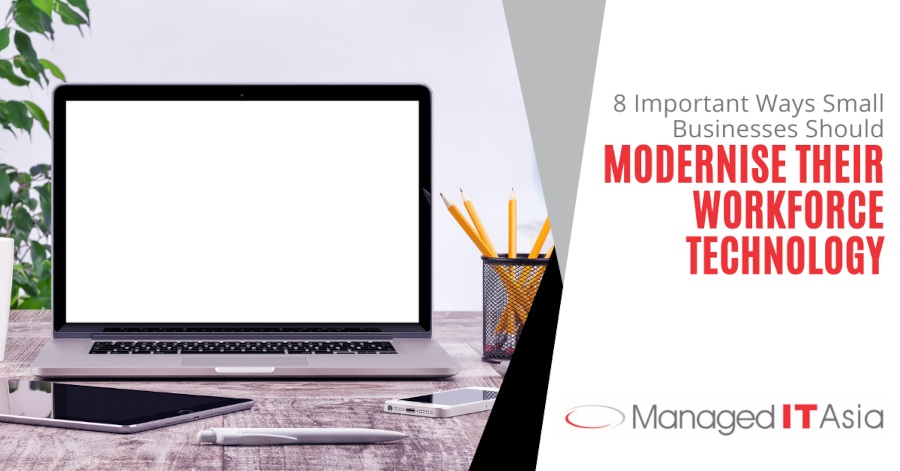In today’s fast-paced business environment, small businesses are increasingly facing challenges that can be mitigated or even overcome through the strategic use of technology. As we delve into the digital era, the need to modernize workforce technology becomes not just beneficial, but essential for staying competitive and efficient. In this comprehensive guide, we will explore various strategies and tools that small businesses can adopt to modernize their workforce technology.
1. Embracing Cloud Computing:
Cost-Effective Solutions:
- Scalability: Cloud computing offers the flexibility to scale resources up or down based on business needs, preventing overinvestment in IT infrastructure.
- Cost Savings: With cloud services, small businesses can save on the capital costs of buying hardware and software.
- Ease of Access: Cloud platforms ensure that employees can access data and applications from anywhere, fostering a mobile and flexible work environment.
Enhanced Collaboration and Productivity:
Cloud-based tools like Microsoft 365 or Google Workspace enable real-time collaboration, increasing productivity and efficiency. Employees can work on documents simultaneously, share files instantly, and communicate effectively regardless of their location.
2. Implementing Cybersecurity Measures:
Risk Management:
- Data Protection: Implementing robust cybersecurity measures helps safeguard sensitive business data against cyber threats.
- Regular Updates and Training: Keeping software updated and training employees on cybersecurity best practices are crucial steps in reducing vulnerability to cyber attacks.
Building a Secure Infrastructure:
Investing in firewalls, antivirus software, and secure Wi-Fi networks forms the backbone of a secure IT infrastructure. Managed IT recommends regular audits and updates to these systems to ensure maximum security.
3. Leveraging Data Analytics:
Informed Decision Making:
- Customer Insights: Data analytics tools can help small businesses understand customer preferences and behavior, leading to more informed decisions.
- Operational Efficiency: Analysing operational data can highlight areas for improvement, streamlining processes and reducing costs.
Competitive Advantage:
Using data analytics, small businesses can gain insights that give them an edge over competitors who may not be leveraging their data effectively.
4. Adopting Automation Technologies:
Enhancing Productivity:
- Task Automation: Automating routine tasks frees up employee time for more strategic work.
- Error Reduction: Automation reduces the chances of human error, enhancing the quality of work.
Cost Reduction:
In the long term, automation can lead to significant cost savings by optimizing resource utilization and improving operational efficiency.
5. Investing in Employee Training and Development:
Keeping Skills Relevant:
- Technology Training: Regular training sessions help employees stay up-to-date with the latest technologies and tools used in the business.
- Skill Development: Encouraging skill development ensures that the workforce is adaptable and can handle evolving technological demands.
Creating a Culture of Continuous Learning:
Fostering a learning culture not only aids in technology adoption but also improves employee satisfaction and retention.
6. Integrating Mobile Technologies:
Workplace Flexibility:
- Remote Access: Mobile technology enables employees to access work-related resources from anywhere, offering flexibility and supporting remote work.
- Communication Tools: Utilising mobile communication tools helps in maintaining connectivity with the team, clients, and partners.
Customer Engagement:
Mobile apps and responsive websites can enhance customer engagement, making it easier for customers to interact with the business.
7. Upgrading to Modern HR Systems:
Streamlined HR Processes:
- Automated Payroll and Benefits: Modern HR systems can automate payroll processing and efficiently manage employee benefits.
- Recruitment and Onboarding: Digital tools can streamline the recruitment and onboarding process, improving the candidate and new hire experience.
Data-Driven HR Decisions:
Leveraging HR analytics can lead to better decision-making regarding talent management, employee engagement, and workforce planning.
8. Fostering a Culture of Innovation:
Encouraging Creative Thinking:
- Idea Sharing Platforms: Implementing platforms for employees to share and discuss ideas can foster innovation.
- Innovation Workshops: Regular workshops or brainstorming sessions can help in generating new ideas and approaches.
Embracing Change:
Creating a work environment that embraces change and encourages experimentation is key to driving innovation and staying ahead of technological trends.
Embracing the Future with Managed IT Asia
As we have seen, modernizing workforce technology is not just about adopting the latest tools, but also about creating a culture that embraces change, fosters innovation, and values continuous learning. At Managed IT Asia, we understand the unique challenges faced by small businesses in this journey. We believe in providing tailored solutions that align with your business goals and support your growth. To discover how we can assist in modernizing your workforce technology and propel your business into a future of efficiency and success, please feel free to contact us. Our team at Managed IT Asia is dedicated to helping you navigate the ever-evolving landscape of business technology.
MANAGED IT ASIA, we are an IT Support, IT Solutioning and Managed IT Service Provider specializing in serving Small Businesses across Asia. Call us at +65 6748 8776 and let us manage your Small Business IT today!
